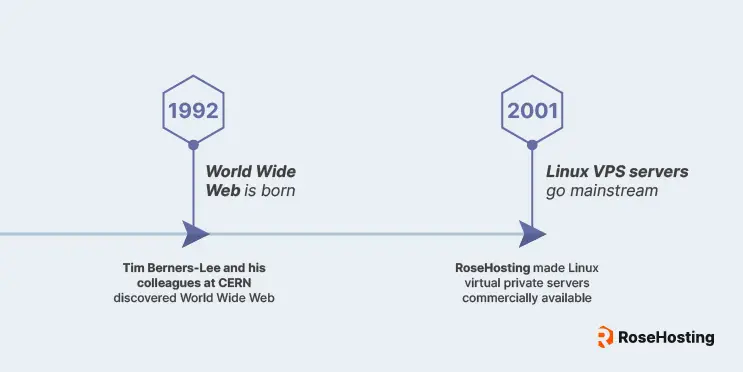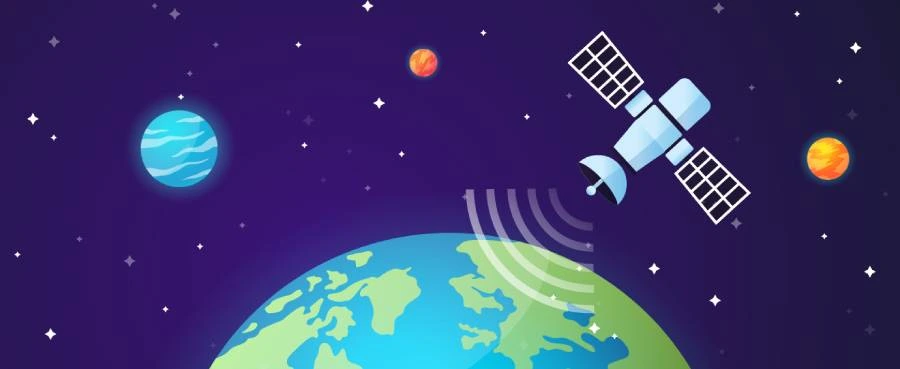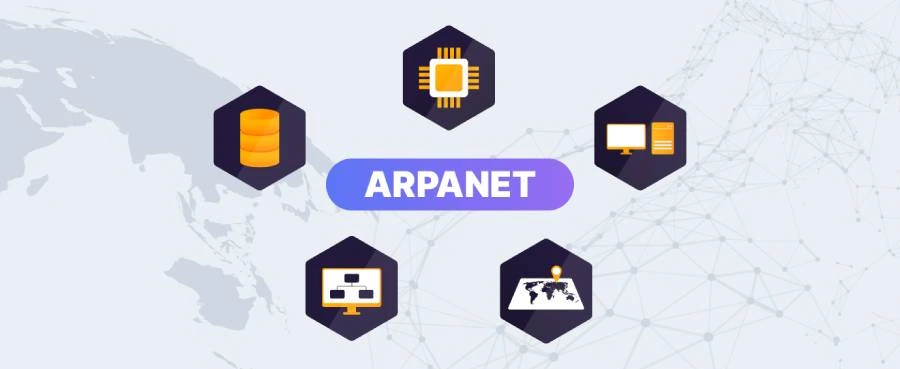
Take a step back and imagine a world with no Internet. No social media, no websites, no e-commerce, or online chat. The world would be a little more dull for most of us.
As hard as it may be to imagine, people did exist prior to the existence of the Internet. Its presence however revolutionized the globe and rapidly created immense opportunities.
So, who invented the Internet? When was the Internet launched? What was the very first message transmitted over the network? These are just some of the more common questions that come to mind once you start falling deeper down this rabbit hole.
As the Internet evolved in the late 1990s, one of the biggest challenges was how to procreate the software changes, particularly the host software. As you read further, you’ll gain an in-depth understanding not only of the history of the Internet but also of the origins of Linux and even see that RoseHosting has a place in history as a Linux hosting pioneer.
First off, let’s travel back to where it all began!
Table of Contents
History of the Internet
The history of the Internet timeline began when Leonard Kleinrock conceived the concept of the World Wide Web. In 1961, he published a piece about the “ARPANET“ in a piece entitled “Information Flow in the Large Communication Nets”. Eight years later, Kleinrock directed the transmission of the first message from his host computer to pass over the Internet on October 29, 1969. Technology has been rapidly developing since then and continues to do so even today.
The Launch of Sputnik

Sputnik, the first artificial satellite, was launched into orbit on October 4, 1957, during the height of the Cold War. This satellite was launched from the Tyuratam launch base in the Kazakh Republic. Americans were alarmed since it was the first time a manufactured object had floated into outer space.
They believed that the Soviet Union was not only technologically superior but also a danger. Americans also thought the Soviets would spy on their enemies, get information to win the Cold War, and launch nuclear assaults.
This wake-up call forced Americans to take science and technology seriously. With this, they funded various agencies, including the Advanced Research Project Agency (ARPA), in 1958. This interlocking system was designed to make critical investments in breakthrough technologies for transformational change and national security. It enabled the growth and development of the field of computer science and space technology.
The Beginning of the ARPANET

Dr. Joseph Carl Robnett Licklider, a director at the U.S. Department of ARPA, was the first who invented the idea of global networking in the 1960s, which ultimately led to the creation of the ARPAnet, the predecessor of the Internet.
He imagined a network of interconnected computers with user-friendly interfaces that would serve as communication devices, allowing everyone to access information and applications from any location easily. Thanks to this American computer scientist, today we benefit from user-friendly interfaces, online banking, graphical computing, digital libraries, e-commerce, and cloud computing.
Licklider set the stage for ARPANET development, and ARPAnet was eventually eclipsed by the Internet in 1966, while it started overgrowing in the early 1970s. By the end of 1969, four host computers were linked to the initial ARPANET, and the Internet started conquering the world.
The Internet’s First Message Ever
On October 29, 1969, a team of scientists led by Leonard Kleinrock successfully transmitted the first message over the ARPANET from UCLA to the Stanford Research Institute, which is hundreds of miles north. That significant moment finally marked the birth of the Internet.
The first message simply read “LO.”
The actual message was supposed to be “LOGIN”. However, the system failed and had to be rebooted, but it was a successful experiment. By the end of the year, there was a connection between four network nodes – UCSB, SRI, UCLA, SRI, and the University of Utah.
Over the years, more computers were quickly connected to the ARPANET. Developing a functionally complete Host-to-Host protocol and other network software continued.
Host-to-Host protocol
In December 1970, the Network Working Group (NWG), working under the supervision of Steve Crocker, accomplished the initial ARPANET Host-to-Host protocol, called the Network Control Protocol (NCP).
During the following two years, the ARPANET sites completed implementing NCP so that the network users could begin to develop applications.
ICCC Demonstration 1971-1972, Arpanet & the Email

The International Conference on Computer Communications (ICCC) was held on October 24-26, 1972, in Washington, with the main aim of motivating network technology completion. This was the first time the general public had seen this revolutionary network technology in action. Robert and Kahn wanted to enhance computer-to-computer connectivity.
The ARPANET’s first networked electronic email system was invented by Ray Tomlinson in 1971. This was the first “hot” application in the simple history of the Internet. Robert achieved this by creating the first email utility that could file, list, read, respond to, and forward messages.
Interesting fact: By 1976, 75% of all ARPANET traffic was electronic mail.
Throughout the following decade, email was the most used app on the network.
The Concept of E-Books Started in 1971

It all started in 1971 when Michael Hart had access to a significant amount of computing time. Then, he realized that the future of computers’ purpose lies not in computation. Instead, it was in the storing, retrieving, and searching of knowledge that, at the time, was only available in libraries.
He painstakingly typed the “Declaration of Independence” (there was no OCR at the time) and started Project Gutenberg. This project announced the beginning of the eBook. Thanks to Michael, today we can reach any information found in various books broadly accessible in electronic form.
Expanding the Network Thanks to TCP/IP
At the beginning of ARPANET, there wasn’t a universal language that enabled machines on different networks to communicate with one another. Back then, the ARPANET was just a trustworthy and secure packet-switched network, so the idea to expand the Web was born. For this to happen, scientists needed an all-encompassing protocol, a set of rules that controls the entire network.
These regulations needed to be stringent enough to ensure secure data transfer and flexible enough to account for all possible data transfer methods. This led to the birth of TCP/IP (Transmission Control Protocol), a set of commonly used protocols that played an essential role in enabling computer devices and application programs to deliver messages over the network successfully.
Robert Kahn, known as one of the “Fathers of the Internet,” invented these protocols and initiated the idea of open-architecture networking. TCP/IP protocol becomes the basis for the Internet’s open architecture, which allows any computer with the appropriate connection to enter the Web.
The changeover of the ARPANET NCP to the TCP/IP in 1983 was another milestone in the simple history of the Internet. All hosts had to convert simultaneously during this “flag-day” shift. If not, they would have had to communicate using highly improvised methods.
By 1985, the Internet was established as a technology supporting a wider community of developers and researchers.
The World Wide Web
During the 1980s, the Internet kept growing at an exponential rate.
Still, only researchers, scientists, and programmers used it a lot to send messages and share information; other people generally had no idea about the Internet.
Not until Tim Berners Lee, a computer scientist, invented the Web in 1989. Tim also came up with fundamental Internet elements, such as HTMPL, HTTP, URI. He also invented the first Web page browser/editor “WorldWideWeb.app” and the first Web server “httpd“. The first Web page was served on the open Internet by the end of 1990.
The Birth of UNIX & Linux

UNIX is an open-source operating system that was first developed in the mid-1970s by Ken Thompson and Dennis Ritchie, and it had a huge impact on the history of computing. This system is developed as a multitasking system for mainframes and minicomputers.
Linux is a computer operating system and a freely distributable version of Unix developed by Finnish software engineer Linus Torvalds and the Free Software Foundation (FSF) in the early 1990s.
During his student days, Torvalds started working on Linux to create a system similar to MINIX, a UNIX operating system. He succeeded in developing the first version of Linux, number 0.02, which was released in 1991. Three years later, another version called 1.0 of the Linux kernel (the lowest-level core component of the operating system), was released.
GNU tools created by the Free Software Foundation helped Linux to come to life. Because of their critical role, distributions of Linux with accompanying utilities were called GNU/Linux. Berkeley Unix (BSD) has also taken part in developing Linux, especially regarding the utilities that come with Linux distributions.
Linux was initially a Unix clone but now is big enough and capable of running the TCP/IP, X Window System, Emacs, Web, mail, and news software. Throughout the 1990s, Linux expanded thanks to the work of developers. Its growth is also thanks to a fast, stable system that rarely crashes.

Key Attributes of Linux
Although the Linux kernel took on many of Unix’s features, it is different in the following ways:
- Its most vital part is the kernel, which is separate from the other parts of the operating system. Simply put, Linux takes parts from different places, like GNU, to make a complete operating system.
- It is open-source and free. The kernel is maintained by a community of developers and is accessible for download and modification. It also works with the GNU General Public License (an outgrowth of the FSF’s work on the GNU Project). The GPL says that derivative work must keep the same licensing conditions as the initial software.
- While it features a monolithic kernel comparable to Unix, it can also load and unload kernel code as needed.
- It differs from traditional Unix implementations because it supports symmetrical multiprocessing (SMP). A single operating system can control multiple processors that share a main memory and access to all devices.
- Linux’s kernel is preemptive. Therefore, the scheduler can force a driver or another part of the kernel to switch contexts while running.
- Its kernel doesn’t know the difference between processes and threads.
- It has a Command Line Interface (CLI) but can include a Graphic User Interface (GUI) (GUI).
Most servers on the Internet use Linux together with Apache, an open-source Web server. Linux is also common in systems as diverse as mobile phones and supercomputers because it’s open-source and can be modified to suit different purposes.
Google’s mobile OS, Android, runs on a modified version of the Linux kernel. Chrome OS, Google’s operating system that runs the Chrome browser, is also based on Linux.
Linux became more popular for home and office desktops when it added user-friendly desktop environments, games, office suites, and browsers. Since the 1990s, new distributions of this software have been created.
Ubuntu, Linux Mint, ZorinOS, Fedora, and elementaryOS are some of the best Linux distros.
Linux Distributions
Slackware
Patrick Volkerding created and launched Slackware 1.0, the oldest actively maintained Linux distribution, in 1993. Now, Slackware is nowhere as famous as it used to be because newer distributions have more user-friendly features.
openSUSE
SUSE (Software and Systems Development) was founded in 1992 by Burchard Steinbild, Hubert Mantel, Thomas Fehr, and Roland Dyroff.
In 2006, an open-source project called openSuse was finally released and remained the most successful business Linux distribution worldwide.
Debian
Debian is another earliest Linux distribution introduced by Ian Murdock in 1993. However, the first stable version didn’t come out until 1996. GNU sponsored Debian development from 1994 to 1995.
The basic idea was to make a stable distribution that anyone could use for free after downloading. Debian also made a mark in the history of the Internet timeline as one of the first Linux distributions to offer live CDs.
Ubuntu
Ubuntu is one of the most popular Linux distros and it is based on the Linux kernel. It was created in response to the demand for a lighter-weight, more user-friendly distribution.
South African Internet tycoon Mark Shuttleworth introduced Ubuntu in 2004 with the release of version 4.10 (Warty Warthog). Despite not supporting all Debian packages, Ubuntu is based on the most recent Debian distribution and uses the same “.deb” package system. Every six months, a new version is made available.
Linux Mint
Linux Mint is one of the most reliable alternatives to Apple macOS and Microsoft Windows. The purpose of this operating system for laptops and desktops, as well as the popular Linux distros, is to produce a user-friendly operating system.
Based on Debian and Ubuntu, Linux Mint is safe to use and offers more than 3000 packages.
RoseHosting Linux VPS
Did you know that RoseHosting became the first and only company to provide commercial Linux virtual servers back in 2001?
Founded in 2001, RoseHosting made a mark in the simple history of the internet as the first company to offer commercial Linux servers. With over 21 years under our belt, we provide quality web hosting services.
Our premium Linux VPS hosting equipment includes:
- Latest Generation Dell PowerEdge rack servers
- Latest Intel Xeon Gold CPUs or better
- 256 GB of DDR5 system RAM or better
- Enterprise-grade PCIe 4.0 NVMe storage
- Gigabit Ethernet Ports or better
- High-performance N+1 redundant network, power and HVAC systems
- Dual redundant Liebert air conditioning systems to keep your server cool
- Redundant dry fire extinguishing systems
- Multiple 10GigE Gigabit and OC-3 connections through Verizon, Level3,
Charter and CenturyLink - Redundant Gigabit Ethernet-based internal network, using Extreme
Networks and Cisco equipment - Redundant, geographically dispersed connectivity to all of the world’s major
backbones
Here are other features and benefits:
Uptime Record
We guarantee a 100% uptime guarantee + 10x money-back SLA. Even if there is a 0.1% downtime, you receive a generous refund. Ultra-fast backbone connectivity, extremely low latency, and ping time for the best hosting experience.
Hand-optimized Linux VPS
To improve your Linux VPS performance, we will optimize your software to keep its highest performance.
No Overselling
We adhere to a strict, transparent “no overselling” policy, meaning that we never push bandwidth and disk space to ensure you get the complete resources you paid for. There are no hidden fees or raised prices for any of our customers.
Fast NVMe
Our clients have access to enterprise-class NVMe hosting storage (ten times faster than traditional hard drives), even on the most basic of shared hosting packages.
Best Host Support
Our Linux administrators have a wealth of knowledge to assist you in resolving any Linux-related problems. It takes them less than five minutes to respond via chat.
Security & Backup
Our Linux VPS hosting plans come with the “Let’s Encrypt” SSL certificate. Another benefit is that we do full server backup every week. Daily backups or a second weekly backup come as additional options.
History of the Internet Timeline
Here is a simple history of the Internet:
1961 to 1980 – History of the Internet Timeline
- 1961: The simple history of the Internet began with Kleinrock’s first publication in 1961.
- 1964: The history of the Internet timeline continues with another publication from Kleinrock.
- 1965: MIT Lincoln Lab uses packet-switching technology to connect two computers.
- 1968: Beranek and Newman, Inc. (BBN) finalizes the Interface Message Processor (IMP) standards. BBN secures a contract with ARPANET.
- 1969: On October 29, 1969, computers at UCLA and Stanford were interconnected for the first time. The first message was supposed to be “Login,” but there was a system crash, and only the message “Lo” was communicated.
- 1971: Gutenberg was launched, marking a turning point in the history of the Internet timeline
- 1972: Ray Tomlinson from BBN introduces network email. The Internet Working Group (INWG) was founded to address the necessity for establishing standardized protocols,
- 1973: As the Royal Radar Establishment (Norway) and University College of London (England) link to ARPANET, global networking becomes a reality. The Internet is created.
- 1974: The first commercial version of the ARPANET is born, introducing the first Internet Service Provider. Bob Kahn and Vinton Cerf publish A Protocol for Packet Network Interconnection. It proposed that all ARPA-like networks should be linked to a standard called the TCP/IP.
- 1976: Queen Elizabeth sends her first email!
- 1977: Dennis Hayes and Dale Heatherington developed the first PC modem in the simple history of the Internet. They sold it to computer hobbyists.
- 1978: The first Bulletin Board System was built. Gary Thuerk sent the first unsolicited commercial email, which is now commonly known as spam, to 600 ARPANET users.
- 1979: Tom Truscott and Jim Ellis proposes the idea of USENET.
- 1980: USENET is born, marking another milestone in the simple history of the Internet.
1981 to 1990 – History of the Internet Timeline
- 1981: The Computer Science Network (CSNET) was created with National Science Foundation (NSF) funding. It was to offer networking services to academic computer scientists.
- 1982: The suite of protocols known as TCP/IP, which consists of Transmission Control Protocol (TCP) and Internet Protocol (IP), became the protocol for the ARPANET. It remains the default protocol for the Internet. Scott Fahlman also proposed using the modern emoticon that same year.
- 1983: Arpanet switches from NCP to TCP/IP protocols. Domain Name System (DNS) creates the popular .com, .mil, .edu, .gov, .org, .net, and .int systems for identifying websites. Unlike the former designation for websites, such as 123.456.789.10, this is simpler to remember.
- 1984: William Gibson, who authored the book, Neuromancer, uses the term “cyberspace” for the first time.
- 1985: The first registered domain, Symbolics.com, is born, marking a spot in the history of the Internet timeline. It belongs to the Massachusetts-based Symbolics Computer Corp.
- 1986: The National Science Foundation’s NSFNET connects to supercomputer facilities at 56,000 bits per second. This is about the same speed as a dial-up modem. As the network speeds up over time, regional research and education networks that NSF partially funds connect to the NSFNET backbone. This makes the Internet reach all parts of the United States. The NSFNET was a kind of network that linked users in academic institutions.
- 1987: On the Internet, there were almost 30,000 hosts. The original Arpanet protocol could only connect up to 1,000 hosts. However, when the TCP/IP standard was adopted, it became possible to connect more hosts.
- 1988: The Internet Relay Chat (IRC) came to the scene. It paved the way for modern real-time chat and instant messaging services. That same year, one of the first Internet worms was released. It caused significant disruptions in several parts of the Internet.
- 1989: World.std.com becomes the first company to offer dial-up Internet access commercially. America Online was also born and made the Internet popular with regular Internet users.
- 1990: Tim Berners-Lee, a scientist at CERN, launches the HTML (HyperText Markup Language). This technology was a significant milestone in the simple history of the Internet.
1991 to 2000 – History of the Internet Timeline
- 1991: CERN introduces the World Wide Web to the world. Gopher, the first search protocol that looked at file contents rather than just file names, debuted. Also, the MP3 format became a standard. Since creators could easily compress MP3 files, they became a popular way to share songs and whole albums over the Internet.
- 1991: The first webcam was one of the most exciting things to happen that year in the simple history of the Internet. It was set up in a computer lab at Cambridge University. And its only job was to keep an eye on a particular coffee maker. The revolutionary LINUX was also launched.
- 1992: The first audio and video went viral over the Internet. The phrase “surfing the web” became common.
- 1993: There are now 600 websites, and both the White House and the United Nations go online. Marc Andreesen launches the Mosaic Web browser. From 1985 to 1993, the number of computers connected to NSFNET went from 2,000 to over 2 million. The National Science Foundation then plans a new Internet architecture to support the growing number of users.
- 1994: Netscape Navigator, the first significant rival to Mosaic, debuted. Microsoft developed a web browser for Windows 95. Jerry Yang and David Filo, two graduate electrical engineering students at Stanford University, founded Yahoo!
- 1995: America Online, Prodigy, and CompuServe start offering Internet access. There was also the launch of eBay, Craigslist, and Amazon.com. The latter didn’t turn a profit until 2001.
- 1995: Brendan Eich launched Java and JavaScript. Match.com, the first online dating site, also debuted. As the Internet transitions to a commercial operation, the original NSFNET backbone falls out of operation.
- 1996: The browser war, mainly between Microsoft and Netscape, worsens. Hotmail, the first cloud-based email service, debuted. A 3D animation called “The Dancing Baby” went viral.
- 1997: Reed Hastings and Marc Randolph started Netflix as a company that sends DVDs to people’s homes by mail. Though blogs had been around for years, the term “weblog” didn’t come into use until 1997.
- 1997: A settlement with the Justice Department lets PC makers remove or conceal Microsoft’s software from Windows 95’s newer versions. Netscape gives free access to its browser.
- 1998: Google came into the scene, changing how people use the Internet. Internet Protocol version 6 was made available so that Internet addresses could grow in the future. Napster also came out, making it easier for people to share audio files over the net.
- 1999: AOL buys Netscape and Napster debuts.
- 2000: The year of the dot-com collapse, which resulted in massive losses for several investors. A large-scale DOS (denial of service) attack hits sites like Yahoo! and eBay showing how vulnerable the Internet can be. AOL and Time Warner merge.
2001 to 2010 – History of the Internet Timeline
- 2001: RoseHosting was founded. It was the first hosting service to offer Linux virtual servers for commercial purposes. Wikipedia, one of the websites that promoted collective web content generation, launched. A federal judge halts Napster’s operation, saying it must find a way to prevent users from sharing copyrighted content before it can continue.
- 2003: The Slammer worm became famous in 10 minutes. Myspace, the Safari Web browser, and Skype began operations. WordPress, the popular blog publishing platform, debuted.
- 2004: Facebook entered the industry, beginning the era of social media in the history of the Internet timeline. Mozilla Firefox launched its browser. The term Web 2.0. became popular.
- 2005: YouTube made its debut, providing free online video hosting and sharing to people. Reddit, the site for social news, was also founded.
- 2006: Twitter first started in 2006. The initial name of the service, inspired by Flickr, was “twttr”, and the first tweet on Twitter said, “Just setting up my twttr.” AOL changed its business approach by making most of its services free. Instead, it relied on advertising to generate revenue.
- 2007: There was a joint venture between Fox, ABC, and NBC, which led to the birth of Hulu, a popular platform to watch movies online. iPhone also made its debut and renewed developers’ interest in web application development.
- 2009: The US relaxed its hold over ICANN, the body in charge of registering domains. This same year, the Internet celebrated its 40th anniversary.
- 2010: Facebook records 400 million active users. Pinterest and Instagram also debuted.
2011- 2022 – History of the Internet Timeline
The simple history of the Internet continues into our present day. Here are the milestones in the history of the Internet timeline:
- 2011: Twitter and Facebook become important in the Middle East revolt.
- 2012: The administration of President Barack Obama says it is against the Stop Online Piracy Act. Technology companies like Google and Wikipedia, and nonprofits like the Electronic Frontier Foundation, worked together to stop the bill.
- 2013: Edward Snowden, a former CIA worker, revealed the NSA’s monitoring program that could tap into the communications of Internet users.
- 2014: Instagram hits 400 million users. This placed it far ahead of Twitter which later hit 316 million users.
- 2016: Google launches its voice assistant.
- 2018: There is a rise in the number of people using Internet-enabled devices. The number hit seven billion by the end of that year.
- 2019: 5G (fifth generation) networks debuted and enabled faster Internet connection.
- 2021: By January this year, over 50% of the world’s population was using the Internet.
- 2022: SpaceX launched over 1,900 satellites, which now provide broadband services in some areas worldwide.
Bottom Line
Hopefully, you had fun taking a trip back through the detailed process of how both the Internet and Linux were born.
We are very proud to share a part of this history as the very first Linux Virtual Private Servers came to life.